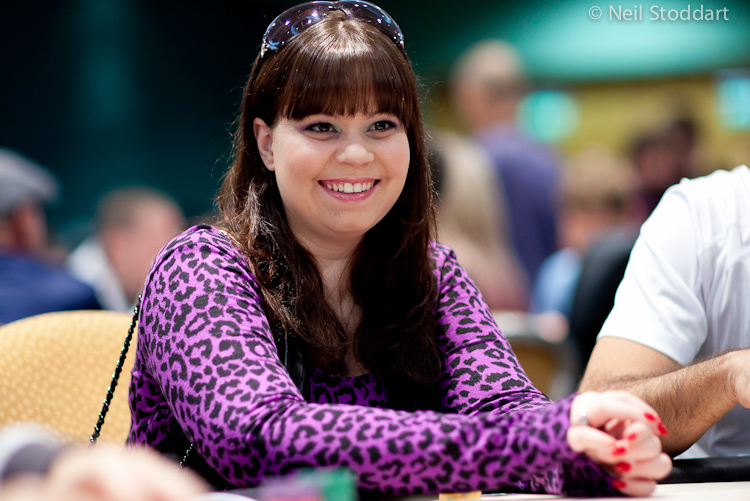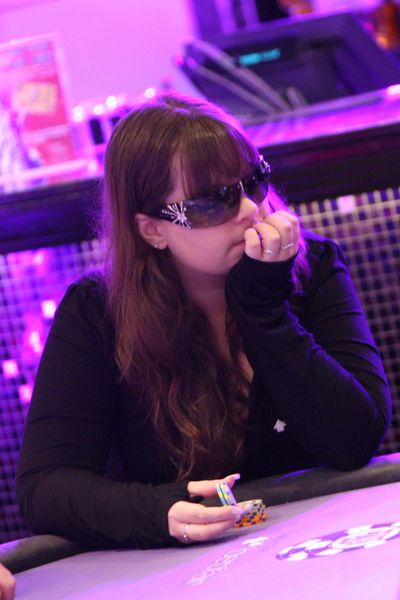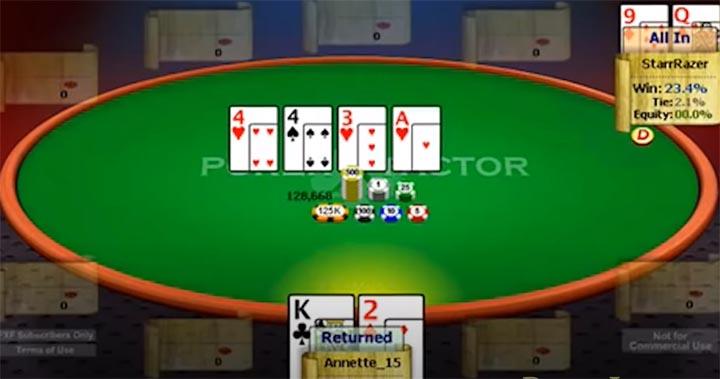Certain online poker legends have pulled off incredible feats that are now the stuff of folklore.
Here are few examples:
- Randy “nanonoko” Lew plays 14,548 online cash hands in eight hours.
- Bertrand “Elky” Grospellier plays 62 sit and go’s (SNGs) in an hour.
- Joey “ChicagoJoey” Ingram plays 50,000 cash hands in one day.
Annette Obrestad is yet one more pro who’s completed an insane challenge. In 2007, she played an entire online poker tournament without looking at her cards and still won.
This accomplishment is something to marvel when considering that knowing one’s cards is a key part of poker. But can Obrestad’s challenge be taken a step further and used to improve your reading skills?
I’ll answer this question by discussing more on how Obrestad won the tournament without looking at her cards. I’ll also offer my conclusion on what playing blind can do for your ability to read opponents.
Who Is Annette Obrestad?

Annette Obrestad was an online poker legend well before she performed her no-look challenge. She began playing at internet poker rooms when she was just 15 years old under the handle “Annette_15.”
The Norwegian poker legend says that she’s never had to deposit, because she won her initial bankroll through freerolls. Freeroll tournaments were Obrestad’s only option at the time, since her mother wouldn’t let her use a credit card to deposit.
Annette Obrestad winning a 180 person Sit&Go without looking at her cards This 2 part video shows how Annette Obrestad won a 180 person Sit&Go by playing position and the player and NEVER looking at her 2 hole cards. You will see her folding KK and great hands because SHE NEVER LOOKS AT THEM. Annette Obrestad is something of an enigma in the world of poker. She came to prominence in 2003 when aged only 15 won several hundred thousand dollars playing poker online. Using her poker name of Annette15, she won the money without ever making a deposit and got her initial stakes from playing in free roll tournaments. In July 2007 she won an online poker tournament against 180 other.
Obrestad earned $9 through a freeroll and never looked back. From September 2006 to February 2007, she earned over $800k through a combination of PokerStars, Full Tilt, and Ultimate Bet.
On Sept. 17, 2007, just one day shy of her 19th birthday, she won the 2007 WSOP Europe Main Event and £1 million ($2.01 million).
Obrestad quickly followed this success up by finishing second in the 2007 PokerStars European Poker Tour Dublin Main Event. She collected €297,800 ($431,184) for this effort.
The Norwegian’s tournament results haven’t been as impressive in recent years. However, Obrestad’s earlier success combined with her online feats have earned her plenty of sponsorships over the years.
She’s had deals with Full Tilt Poker, Betfair, and Lock Poker. The latter sponsorship didn’t go so well for Obrestad, though, because Lock Poker closed without reimbursing players in 2015.
Despite being associated with a tainted poker site, Obrestad is still one of the game’s most-famous players today. She routinely draws interviews whenever she plays at the WSOP or elsewhere.
Obrestad’s No Look Poker Feat
In July 2007, not long before her WSOP Europe Main Event victory, Obrestad entered a $4 buy-in, 180-player SNG. She played nearly the entire tournament without looking at her cards.
Obrestad used a sticky note to cover the spot on her computer screen where her hole cards were shown. She only looked at her hole cards once when she was facing an important all-in call.

Outside of this, though, Obrestad battled through the entire 180-player field without checking her cards. It’s amazing is that she won such a large SNG without ever knowing her hand strength.
The only problem with Obrestad’s victory that nobody was there to film it. However, she’s widely believed to be telling the truth based on her other tournament successes.
She won a PokerStars Sunday Hundred Grand event on March 2008. Obrestad collected $20,000 in this $11 buy-in event after topping a 20,000-player field.
For example, she won a PokerStars Sunday Hundred Grand event on March 2008. Obrestad collected $20,000 in this $11 buy-in event after topping a 20,000-player field.
She took down a Betfair $125k Sunday tournament in June 2008, earning the $35,000 top prize. Obrestad also claimed victory in a PokerStars Sunday $500k in May 2010, collecting $87,400 for the finish.
Aside from her poker tournament acumen, it’s unlikely that she would make up such an accomplishment. This is especially true when she was so specific about only looking at her cards once.
She also posted her hand histories online after the event. Therefore, many consider this to be a valid internet poker feat and one that has since yet to be repeated in a large online tournament.
Why Did Obrestad Play a Tournament Blind?
Obrestad played the $4, 180-player SNG without checking her cards for two reasons:
Annette Obrestad Wins Without Looking At Cards Video
- To show the importance of table position and reading opponents.
- To show that the cards you hold are overvalued to a degree.
Of course, she was 18 at the time and already had a few years of online poker success under her belt. This helped to a great degree when evaluating her opponents.
Obrestad was facing off against lots of “loose-passive limpers” who generally folded postflop every time they failed to hit a hand. She had to adjust her game, because she was used to competing against more-skilled regs.
Obrestad put her complete hand history on the training site PokerXFactor.com following the win. This allowed everybody to see the exact hands she held while only focusing on opponents and table position.
“I had done that on a regular basis before playing $30, $40 and $50 sit-and-gos,” she said. “But the tournament that was recorded was actually the first and only time I did it for the public.”
The hand histories show that she got lucky a couple of times and had some fortune suckouts. Obrestad also sometimes folded pocket aces and pocket kings preflop, adding legitimacy to her no-look claim.
Annette would show off the ability to play without looking at her cards in future online events too.
Can Obrestad’s No Look Challenge Improve Your Poker Skills?
Finding the balance between judging your hand strength and noting opponents’ tendencies can be hard.
Many beginners put most of their attention on the cards and pay less mind to how others are playing. Obrestad’s no-look challenge is a good exercise to break out of this habit.
After all, you’re playing hands based purely on your knowledge of opponents and table position. You’re not, however, worrying about if AQ is strong enough to call another player’s 3-bet.
I don’t recommend playing a lot of online tournaments without looking at your cards. But this method is definitely worth trying from time to time.
You can minimize your risk by playing blind in a low-stakes tourney, much like Obrestad did. It’s also helpful to adjust your playing style to take advantage of passive limpers.
You’re unlikely to win a larger tourney like Annette_15 did. But you can at least give the blind exercise a few tries and see how far you get.
Drawbacks to Practicing Without Looking at Your Cards
I’m a fan of trying Obrestad’s no-look challenge at least once. But it’s far from a perfect training method.
The first problem is that playing without viewing your cards is highly impractical. You’re supposed to use your own hand strength in relation to opponents and table position to make decisions.
It’s not, however, something that should be part of your daily practice routine.
Another issue is that Obrestad only won a $4 tourney without looking at her hands. She obviously felt that using this strategy at higher stakes wasn’t feasible.
Those who play tournaments with higher buy-ins tend to have better overall strategy. Obrestad needed to get lucky a few times to win the $4 event. It’s highly unlikely that she could’ve won a $22 buy-in event or greater without looking.
This brings me to another point in that online poker competition wasn’t quite at the level back then that it is now. Even she admits in a recent interview that the players are much tougher today.
“You can’t even compare online now to back then,” said Obrestad. “It’s almost impossible these days to make a good living playing poker. It’s really hard.”
Annette Obrestad Height
Just because the competition is tougher today doesn’t mean you can’t effectively use the no-look strategy. But just note that it won’t be the same as when Annette used it.
Other Good Methods for Profiling Online Poker Opponents
If you do train without looking at your cards, then you’ll want to mix in some methods for reading your opponents.
Becoming great at reading internet players takes time and practice. But the following tips can get you off to a good start when studying tournament opponents.
Postflop Bet Sizing
One of the easiest ways to judge your opponents’ skill level is by looking at their postflop bet sizing.
Good players usually bet half the pot or more after the flop. This gives opponents worse pot odds so that they have a tougher time chasing draws.
Weaker players, on the other hand, will bet much less than half the pot. This move is usually an indication that their hand is weak and/or they don’t understand how to make opponents pay to see the next card.
Preflop Bet Sizing
Many experienced players enter pots with a raise worth 2.5x to 3x the big blind (bb). Doing so accomplishes multiple goals:
- Masks hand strength.
- 3xbb is large enough to force out weak drawing hands.
- 3xbb is small enough to mitigate risk if somebody makes a big re-raise.
Bad players are all over the place with their preflop raises. They may limp into multiple pots, then suddenly go all-in when they have pocket queens.
The latter move is especially bad because it can either expose them to too much risk (vs. aces or kings) or push everybody out of the pot. It’s important to extract maximum value out of hands like these, rather than to simply scoop a tiny preflop payout.
Aggressive vs. Passive Play
Passive play is another way to spot recreational gamblers. Losing players call lots of raises both before and after the flop. They’ll also fold quite often before reaching the showdown.
Skilled grinders differ because they’re willing to re-raise pre-flop and continue their aggression post-flop. These players are tougher to deal with since they can win pots by having the best hand or forcing an opponent to fold.
Betting Strategies During Different Tournament Stages
The advice above is based on profiling poker players’ general betting styles. But tournaments require players to vary their betting strategies as an event rages on.
The reason why is because they must make adjustments based on their stack size and the increasing blinds. The goal is to keep a healthy chip stack in comparison to the blinds and avoid entering desperation mode.
They realize that they can wait for good opportunities and avoid getting into all-in situations.
Inexperienced players, on the other hand, might go all-in multiple times during the early stages. They’re willing to take unnecessary risks, even when the blinds don’t force them to.
But they have the exact opposite approach later on in a tourney when the blinds do become a factor.
Instead of being more aggressive and trying to keep a decent chip stack, they play tentative and are afraid to bust out. This lets the blinds eat away at their stack, costing them leverage.
Better players know that it’s important to have at least 10bb or more for raising and all-in leverage. They’re willing to make larger raises to maintain or build their chip stack.
Multi-Tabling
Many internet poker sites let you search opponents by their handle. Doing so lets you see how many tables they’re playing at once.
Recreational players normally only play 1-2 tables at once, even at the lower stakes. They realize that they don’t have the skills to profit off multi-tabling several tables.
Low-stakes regulars, in contrast, may play anywhere from 4-10 tables to increase their hourly profit rate.

Some players block themselves from being searched. This usually indicates that they’re a good grinder who doesn’t want to reveal info on their playing habits.
Chatting During Play
Most regulars simply turn the chat box off when playing. They don’t care about chatting with others and may not even have time to do so if they’re multi-tabling.
The chat box is more popular among recreational players who are looking for entertainment. If they try to initiate a chat with you multiple times throughout a session, then they’re likely an amateur.
Heads-Up Displays
A heads-up display (HUD) makes your life much easier when reading online opponents. HUDs show statistics on your opponents’ tendencies, thus helping you better recognize their patterns.
The two most important stats to consider are voluntarily put money in the pot (VPIP) and preflop raise percentage (PFR).

VPIP indicates how many hands an opponent is willing to play. The meaning of the numbers differs based on the type of tournament (i.e. 6 max or full ring).
Generally speaking, though, a low VPIP (5-15%) represents a nitty player. A higher VPIP (25-35%) indicates somebody who’s not afraid to pay to see flops.
PFR shows how often players raise on the flop. Somebody with a high PFR and VPIP is a loose-aggressive player who bets big with a wide hand range. A player with a low PFR/high VPIP limps into lots of pots, which is a bad strategy.
You should definitely make use of a HUD if your poker room allows them in tourneys.
They can be awkward to play with at first. But HUDs are almost a necessity in order to profit off today’s game.
Conclusion
Annette Obrestad may not be crushing tournaments like she used too. However, she’s still an online poker trailblazer who lays claim to many legendary feats – including winning a tourney while playing blind.
It’s unclear whether she’s the first player to complete this feat. But Obrestad is the first well-known case of somebody who beat a large online tournament without checking their cards.
She did look once when faced with an all-in decision. But this can be forgiven considering that she fought through a 180-player field.
Aside from Obrestad’s no-look challenge serving as a marvel, it can also help improve your game.
This exercise is especially effective if you’re a beginner who’s too reliant on your hand strength. You may still try this challenge even if you’re an experienced player who’s looking for a new training tactic.
Of course, it’s important to remember all of the basic reading skills when doing so. Looking at your opponents’ preflop bet sizing, post-flop bet sizing, overall aggression, and more helps you get strong reads.
In summary, I encourage you to try playing at least one online tourney without looking at your cards. You may even consider using this training technique multiple times if you see strong benefits in it.
Please enable JavaScript to view the comments powered by Disqus.From winning the 2007 WSOP Europe Main Event as an 18-year-old to starting her poker career through freerolls, Annette Obrestad has become one of poker’s living legends. But if there’s one act that truly defines Obrestad’s career more than anything else, it’s when she won an online tournament without looking at her cards.
The Norwegian was playing in a $4 buy-in, 180-player sit and go and decided to go in blind. According to Wikipedia, she only looked at her cards once during the entire tournament. The idea was to “show just how important it is to play position and to pay attention to the players at the table.”
That was back in 2007, and Obrestad says that she still gets asked about the impressive tournament win. In a recent interview with PokerListings, the 25-year-old said that she put some paper over the screen where her cards were. “At first it was kind of weird because it was so different to not be able to have any other reads,” she recalled. “Just like bet sizing and how people had played before. And the more I played the more I realized that you actually don’t always need to see your cards to pick up on stuff.”
Obrestad also discussed the lessons that players can learn from her blind tournament victory. “Basically what it comes down to is that poker is a game of reading people,” she explained, “and the more you play the more you understand how the betting patterns work and how people think. And once you can kind of get into people’s heads, understand more how they play. And that’s really what you have to do to become a good player – it’s not so much about the cards.”
Obrestad finished by saying that many people who sit at live tables with her ask if the legend of the blind tournament win is true. She added that more people recognize her for winning a tourney without looking at her cards than for the WSOPE victory.